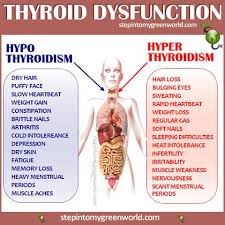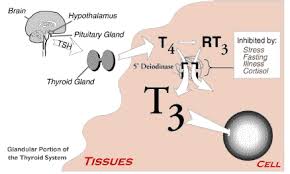Thyroid Gland Health
Your thyroid gland is located in your neck on top of your ‘Adam’s Apple”, you have a right and left half and it is responsible for maintaining your metabolism. You have another small gland the Parathyroid which I will cover in the next post. The thyroid gland gets it’s orders from the Pituatary Gland which is in the brain itself. The thyroid is affected by many things like diet (needs iodine), stress reacts to the Adrenal glands(stress glands) and the brain chemistry itself. Many symptoms of general pooor health can be traced back to thyroid malfunctions. So understanding the lab tests that are used to assess it can be helpful.
HOW DOES THE THYROID GLAND FUNCTION?
The main hormone secreted by the thyroid gland is thyroxine, also called T4 because it contains four iodine atoms. T4 increases metabolism and is converted to triiodothyronine (T3) by the removal of an iodine atom. This occurs mainly in the liver and in certain tissues where T3 works, such as in the brain. The amount of T4 that the thyroid gland makes is controlled by another hormone, which is made in the pituitary gland, called thyroid stimulating hormone (TSH). The amount of TSH that the pituitary releases into the blood depends on the amount of T4 that the pituitary detects. If the pituitary detects only a small amount of T4, then it produces more TSH to tell the thyroid gland to produce more T4. Once the T4 in the blood stream goes above a certain level, the pituitary’s production of TSH is shut off. The thyroid and pituitary glands act similarly to a heater and thermostat. When the heater is off and it becomes cold, the thermostat detects the drop in temperature and turns on the heater. When the heat rises to the appropriate level, the thermostat senses this and turns off the heater. Thus, the thyroid and the pituitary, like a heater and thermostat, turn on and off regulating metabolism.
Thyroid Blood Tests
Blood tests to measure TSH, T4, T3 and Free T4 are readily available and widely used. Tests to evaluate thyroid function include the following:

Symptoms of Thyroid Issues
TSH TESTS
The best way to initially test thyroid function is to measure the TSH level in a blood sample. A high TSH level indicates that the thyroid gland is failing because of a problem that is directly affecting the thyroid (primary hypothyroidism). The opposite situation, in which the TSH level is low, usually indicates that the person has an overactive thyroid that is producing too much thyroid hormone (hyperthyroidism). Occasionally, a low TSH may result from an abnormality in the pituitary gland, which prevents it from making enough TSH to stimulate the thyroid (secondary hypothyroidism). In most healthy individuals, a normal TSH value means that the thyroid is functioning normally.
T4 TESTS
T4 circulates in the blood in two forms:
1) T4 bound to proteins that prevent the T4 from entering the various tissues that need thyroid hormone.
2) Free T4, which does enter the various target tissues to exert its effects. The free T4 fraction is the most important to determine how the thyroid is functioning, and tests to measure this are called the Free T4 (FT4) and the Free T4 Index (FT4I or FTI). Individuals who have hyperthyroidism will have an elevated FT4 or FTI, whereas patients with hypothyroidism will have a low level of FT4 or FTI.
Combining the TSH test with the FT4 or FTI accurately determines how the thyroid gland is functioning.
The finding of an elevated TSH and low FT4 or FTI indicates primary hypothyroidism due to disease in the thyroid gland. A low TSH and low FT4 or FTI indicates hypothyroidism due to a problem involving the pituitary gland. A low TSH with an elevated FT4 or FTI is found in individuals who have hyperthyroidism.
T3 TESTS
T3 tests are often useful to diagnosis hyperthyroidism or to determine the severity of the hyperthyroidism. Patients who are hyperthyroid will have an elevated T3 level. In some individuals with a low TSH, only the T3 is elevated and the FT4 or FTI is normal. T3 testing rarely is helpful in the hypothyroid patient, since it is the last test to become abnormal. Patients can be severely hypothyroid with a high TSH and low FT4 or FTI, but have a normal T3. In some situations, such as during pregnancy or while taking birth control pills, high levels of total T4 and T3 can exist. This is because the estrogens increase the level of the binding proteins. In these situations, it is better to ask both for TSH and free T4 for thyroid evaluation.
THYROID ANTIBODY TESTS
The immune system of the body normally protects us from foreign invaders such as bacteria and viruses by destroying these invaders with substances called antibodies produced by blood cells known as lymphocytes. In many patients with hypothyroidism or hyperthyroidism, lymphocytes make antibodies against their thyroid that either stimulate or damage the gland. Two common antibodies that cause thyroid problems are directed against thyroid cell proteins: thyroid peroxidase and thyroglobulin. Measuring levels of thyroid antibodies may help diagnose the cause of the thyroid problems. For example, positive anti-thyroid peroxidase and/or anti-thyroglobulin antibodies in a patient with hypothyroidism make a diagnosis of Hashimoto’s thyroiditis. If the antibodies are positive in a hyperthyroid patient, the most likely diagnosis is autoimmune thyroid disease.
THYROGLOBULIN
Thyroglobulin (Tg) is a protein produced by normal thyroid cells and also thyroid cancer cells. It is not a measure of thyroid function and it does not diagnose thyroid cancer when the thyroid gland is still present. It is used most often in patients who have had surgery for thyroid cancer in order to monitor them after treatment. Tg is included in this brochure of thyroid function tests to communicate that, although measured frequently in certain scenarios and individuals, Tg is not a primary measure of thyroid hormone function.
NON-BLOOD TESTS
RADIOACTIVE IODINE UPTAKE
Because T4 contains much iodine, the thyroid gland must pull a large amount of iodine out from the blood stream in order for the gland to make an appropriate amount of T4. The thyroid has developed a very active mechanism for doing this. Therefore, this activity can be measured by having an individual swallow a small amount of iodine, which is radioactive. The radioactivity allows the doctor to track where the iodine molecules go. By measuring the amount of radioactivity that is taken up by the thyroid gland (radioactive iodine uptake, RAIU), doctors may determine whether the gland is functioning normally. A very high RAIU is seen in individuals whose thyroid gland is overactive (hyperthyroidism), while a low RAIU is seen when the thyroid gland is underactive (hypothyroidism). In addition to the radioactive iodine uptake, a thyroid scan may be obtained, which shows a picture of the thyroid gland.
Credits:

